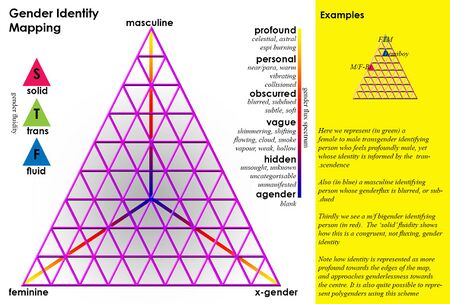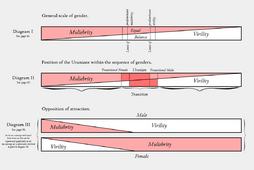Gender spectrum: Difference between revisions
imported>Armorica Online (Although included in the Uranian article, Ludwig Frey's charts work very well here as well) |
imported>TXJ (→History: I put the earlier one first and clarified the 1980s one as being specifically the English phrase) |
||
| Line 10: | Line 10: | ||
==History== | ==History== | ||
One of the earliest references to a gender spectrum in literature may have been from German legal author Prof. Ludwig Frey, when he uses the German language term ''Geshlechtsreihe'' in his 1898 book ''Die Männer des Rätsels und der Paragraph 175 des Deutschen Reichsstrafgesetzbuches'' ("The Men of Riddles and Paragraph 175 of the German Imperial Criminal Code").<ref name="Frey">{{Cite book|url=http://archive.org/details/DieMaennerDesRaetselsUndDerParagraph175DesDeutschen|title=Die Männer des Rätsels und der Paragraph 175 des Deutschen Reichsstrafgesetzbuches|last=Frey|pages=216|first=Ludwig|publisher=Verlag von Max Spohr|year=1898|location=Leipzig}}</ref> Although this is not explicitly the term "gender spectrum", ''Geshlechtsreihe'' can be translated to mean a scale/spectrum/sequence of genders/sexes.<gallery widths="260" heights="170"> | One of the earliest references to a gender spectrum in literature may have been from German legal author Prof. Ludwig Frey, when he uses the German language term ''Geshlechtsreihe'' in his 1898 book ''Die Männer des Rätsels und der Paragraph 175 des Deutschen Reichsstrafgesetzbuches'' ("The Men of Riddles and Paragraph 175 of the German Imperial Criminal Code").<ref name="Frey">{{Cite book|url=http://archive.org/details/DieMaennerDesRaetselsUndDerParagraph175DesDeutschen|title=Die Männer des Rätsels und der Paragraph 175 des Deutschen Reichsstrafgesetzbuches|last=Frey|pages=216|first=Ludwig|publisher=Verlag von Max Spohr|year=1898|location=Leipzig}}</ref> Although this is not explicitly the term "gender spectrum", ''Geshlechtsreihe'' can be translated to mean a scale/spectrum/sequence of genders/sexes.<gallery widths="260" heights="170"> | ||
File:Ludwig Frey charts - original.png|Frey's original charts, with the top and middle depicting spectrums of gender identities. | File:Ludwig Frey charts - original.png|Frey's original charts, with the top and middle depicting spectrums of gender identities. | ||
File:Ludwig Frey charts - translated.png|Translated and digitally-restored versions of Frey's charts, with the middle one intending to place [[Uranian|Uranians]] upon a gender spectrum | File:Ludwig Frey charts - translated.png|Translated and digitally-restored versions of Frey's charts, with the middle one intending to place [[Uranian|Uranians]] upon a gender spectrum | ||
</gallery> | </gallery> | ||
The phrase "gender spectrum" in English dates back at least to the 1980s. For example, in a 1985 issue of the [[crossdressing]]/[[transsexual]]ism magazine "Tapestry", a listing for a therapy group is described as including "transsexuals, transvestites and persons who are trying to find themselves on the gender spectrum."<ref>"Tapestry Issue 46 (1985)." Periodical. ''Digital Transgender Archive'', https://www.digitaltransgenderarchive.net/files/6682x4006 (accessed October 02, 2020).</ref> | |||
==References== | ==References== | ||
{{reflist}} | {{reflist}} | ||
[[Category: Concepts]] | [[Category: Concepts]] | ||
Revision as of 18:34, 26 September 2021
| |
This article lacks significant content. You can help the Nonbinary wiki by completing it! Note to editors: remember to always support the information you proved with external references! |
Gender spectrum or gender continuum[1][2] is a term often used as a metaphor to help explain nonbinary identities.
In its most simplistic form, the gender spectrum is a line going from male on one end to female on the other end. However, this does not fully adequately include all genders; many nonbinary genders are not "between male and female" (for example maverique, agender, or
The phrase "on the gender spectrum" is sometimes used as a synonym for "nonbinary" or "gender nonconforming".[3][4]
Gender Spectrum is also the name of a USA-based gender inclusion organization.
History
One of the earliest references to a gender spectrum in literature may have been from German legal author Prof. Ludwig Frey, when he uses the German language term Geshlechtsreihe in his 1898 book Die Männer des Rätsels und der Paragraph 175 des Deutschen Reichsstrafgesetzbuches ("The Men of Riddles and Paragraph 175 of the German Imperial Criminal Code").[5] Although this is not explicitly the term "gender spectrum", Geshlechtsreihe can be translated to mean a scale/spectrum/sequence of genders/sexes.
Translated and digitally-restored versions of Frey's charts, with the middle one intending to place Uranians upon a gender spectrum
The phrase "gender spectrum" in English dates back at least to the 1980s. For example, in a 1985 issue of the crossdressing/transsexualism magazine "Tapestry", a listing for a therapy group is described as including "transsexuals, transvestites and persons who are trying to find themselves on the gender spectrum."[6]
References
- ↑ Keig, by Zander (27 September 2012). "Gender Continuum". Campus Pride. Retrieved 8 October 2020.
because now I feel able to express myself, along the gender continuum, without reservation
- ↑ Cabaj, Robert Paul. "Working with LGBTQ Patients". psychiatry.org. Retrieved 8 October 2020.
The gender continuum breaks down into separate, but not mutually exclusive masculine and feminine continuums.
- ↑ "Sexuality and Gender: Locked in, and Out". Women and Prison. 2020. p. 90.
While prisoners who identify on the gender spectrum overwhelmingly say that their gender is not affirmed how they would identify, there are some that note being on the gender spectrum is easier than being transgender.
- ↑ Ehrensaft, Diane (2016). The Gender Creative Child. p. 106.
...the jury is still out as to exactly why we are seeing this high incidence of children on the autism spectrum showing up also as children on the gender spectrum...
- ↑ Frey, Ludwig (1898). Die Männer des Rätsels und der Paragraph 175 des Deutschen Reichsstrafgesetzbuches. Leipzig: Verlag von Max Spohr. p. 216.
- ↑ "Tapestry Issue 46 (1985)." Periodical. Digital Transgender Archive, https://www.digitaltransgenderarchive.net/files/6682x4006 (accessed October 02, 2020).



